Apr 29, 2009
The Pacific Ocean’s Influence on Climate Change: How Low Will the PDO Go?
By Jeremy Ross, PhD
Long-term variations in ocean circulations produce pronounced patterns of sea surface temperature (SST) anomalies that directly impact weather and climate. The most influential long-term oceanic cycle is the Pacific Decadal Oscillation (PDO), a large-scale phenomenon in the North Pacific that produces inter-decadal oscillations of cool and warm SST anomalies, with each phase typically lasting 20 to 30 years. During the cool (negative) phase of the PDO, a large horseshoe-shaped area of cooler than average SST extends from the central equatorial tropics northeastward to the Mexican and U.S. coastlines, then northward along the Canadian and Alaskan coastlines. During the warm (positive) phase the pattern is reversed with warm SSTs replacing the cool SSTs. The Atlantic Ocean experiences a similar oscillation known as the Atlantic Multidecadal Oscillation (AMO) which has profound impacts on the number and intensity of Atlantic hurricanes as well as Arctic sea ice extent.
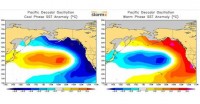
See larger image here.
After a period of intense cooling in the 1950s, 1960s, and 1970s, the PDO returned to the positive phase during the late 1970s and remained generally positive through the late 1990s. Since 1999, a transition into the cool phase has been underway, and during 2008 the transition was completed as recent observations of the coastal waters have been among the coolest in the past 109 years.
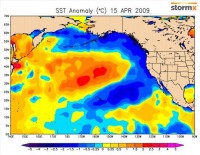
See larger image here.
Long-term variations in ocean circulations produce pronounced patterns of sea surface temperature (SST) anomalies that directly impact weather and climate. The most influential long-term oceanic cycle is the Pacific Decadal Oscillation (PDO), a large-scale phenomenon in the North Pacific that produces inter-decadal oscillations of cool and warm SST anomalies, with each phase typically lasting 20 to 30 years. During the cool (negative) phase of the PDO, a large horseshoe-shaped area of cooler than average SST extends from the central equatorial tropics northeastward to the Mexican and U.S. coastlines, then northward along the Canadian and Alaskan coastlines. During the warm (positive) phase the pattern is reversed with warm SSTs replacing the cool SSTs. The Atlantic Ocean experiences a similar oscillation known as the Atlantic Multidecadal Oscillation (AMO) which has profound impacts on the number and intensity of Atlantic hurricanes as well as Arctic sea ice extent.
After a period of intense cooling in the 1950s, 1960s, and 1970s, the PDO returned to the positive phase during the late 1970s and remained generally positive through the late 1990s. Since 1999, a transition into the cool phase has been underway, and during 2008 the transition was completed as recent observations of the coastal waters have been among the coolest in the past 109 years.
The average PDO index from April 2008 to March 2009 was -1.46, the third lowest yearly averaged March value since 1900, trailing only March of 1956 and 1951. For the next two or three decades, North Pacific SST anomalies will favor the negative phase, and will likely produce exceptional climate patterns and weather events that have not been observed in more than three decades.
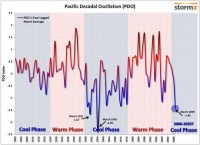
See larger image here.
The strongly negative PDO was influential in shaping North American climate during the past year. In 2008, Anchorage, Alaska, recorded only 2 days above 70 degrees F, the least number of days to exceed 70 since records began in 1917. The PDO strongly influenced the winter of 2008/2009 with dry conditions and warmth in the south central U.S. and snowy and colder than average temperatures in the Northern Plains. Although the PDO will continue to be the dominant climate driver for the remainder of 2009, its impacts will subside during the summer when the atmospheric flow weakens and climate is more strongly affected by local influences such as land conditions and proximity to water bodies.
Read more here.
Apr 27, 2009
Open Water at the North Pole 1958 and 1959
By Anthony Watts, Watts Up With That
What would NSIDC and our media make of a photo like this if released by the NAVY today? Would we see headlines like “NORTH POLE NOW OPEN WATER”? Or maybe “Global warming melts North Pole”? Perhaps we would. sensationalism is all the rage these days. If it melts it makes headlines.
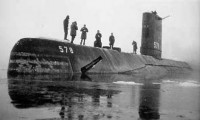
From John Daly:
For example, one crew member aboard the USS Skate which surfaced at the North Pole in 1959 and numerous other locations during Arctic cruises in 1958 and 1959 said:
“the Skate found open water both in the summer and following winter. We surfaced near the North Pole in the winter through thin ice less than 2 feet thick. The ice moves from Alaska to Iceland and the wind and tides causes open water as the ice breaks up. The Ice at the polar ice cap is an average of 6-8 feet thick, but with the wind and tides the ice will crack and open into large polynyas (areas of open water), these areas will refreeze over with thin ice. We had sonar equipment that would find these open or thin areas to come up through, thus limiting any damage to the submarine. The ice would also close in and cover these areas crushing together making large ice ridges both above and below the water. We came up through a very large opening in 1958 that was 1/2 mile long and 200 yards wide. The wind came up and closed the opening within 2 hours. On both trips we were able to find open water. We were not able to surface through ice thicker than 3 feet.” - Hester, James E., Personal email communication, December 2000
Seadragon (SSN-584), foreground, and her sister Skate (SSN-578) during a rendezvous at the North Pole in August 1962:

And of course then thereís this famous photo:
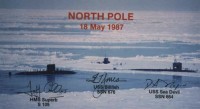
The point illustrated here: the North Pole is not static, ice varies significantly. The Arctic is not static either. Variance is the norm.
There’s quite an interesting read at late, great John Daly’s website, including a description of “the Gore Box”. Everybody should have one of those. h/t to WUWT commenters Stephen Skinner, Crosspatch, and Glenn.
Apr 27, 2009
Dr. Leonard Weinstein (former NASA Senior Research Scientist) Shows How AGW Is Not A Problem
By Marc Morano, ClimateDepot.com on GlobalWarmingHoax post
Dr. Leonard Weinstein worked 35 years at the NASA Langley Research Center, finishing his career there as a Senior Research Scientist. Dr. Weinstein is presently a Senior Research Fellow at the National Institute of Aerospace. He is now a critic of the anthropogenic theory of global warming. His analysis shows that man has contributed less than 0.3C of warming and by the year 2100 may contribute less than 0.4C additional warming. This is much less than what the United Nations IPCC has predicted and of course a small fraction of what alarmists such as Al Gore and James Hansen have predicted.
Below is a summary of Dr. Weinstein’s work, we highly recommend you follow the links to read the complete papers. His work is compelling and is yet one more example of a prominent scientist that disagrees with the anthropogenic theory of global warming.
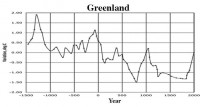
“Preparing for the possibility of an impending ice age along with the possible consequences of a reduction in Earthís magnetic field are real concerns. Concern with relatively small effects of possible anthropogenic caused global warming is a misplaced distraction, and will probably lead to the public losing confidence in scientists, and could weaken the support needed when real problems occur.”
“Decreasing availability of oil and anthropogenic pollution (not greenhouse gasses) are real issues. Acid rain, smog, and dirty water sources do need to be fixed. The problems associated with high fuel prices, and dependence on sources of energy from possibly less than friendly foreign countries are critical. While we canít solve the problems with a single magic bullet, more nuclear power plants, along with wind and Solar power, could fill much of the gap. There are solutions, but first we have to identify the correct problems.”
Leonard Weinstein received a B.Sc. in Physics in 1962 from Florida State University. He started work at NASA Langley Research Center in June 1962. While at Langley, Leonard obtained his Master and Doctor of Science degrees in Engineering from the George Washington University. He continued to work at NASA Langley until June 2007, ending as a Senior Research Scientist. Dr. Weinstein is presently a Senior Research Fellow at the National Institute of Aerospace Read full paper here.
Apr 27, 2009
92F New York City in April Portends a Coolish U.S. Summer
By Joseph D’Aleo
Temperatures leaped to 92F at Central Park today as a storm developing over the central pumped warm air east. The air was very dry as vegetation is still mainly dormant. A cooling sea breeze quickly cooled the city but most inland areas stayed in the low 90s. Another very warm day or two are expected this week before wetter cooler weather comes east.
One of the warmest days occurred in April 1976 when it reached 96F in New York City on the 18th of the month. It also reached 90F in 1977. How unusual is that. Well it is pretty common actually in the last half of the month.
Empirically most forecasters have observed early heat seems often to be followed by seasonable to cooler temperatues in the following summer for the United States. I looked at the years with 90F in New York City in the last century.
Here is what the summer for the United States temperaturewise looked like.
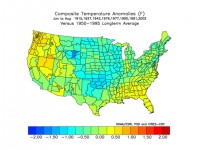
That jives with 3rd summers of La Nina’s trending towards El Nino:
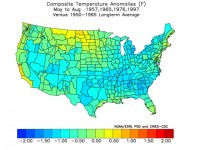
With years with similar, solar, ocean cycles, QBO and other factors:
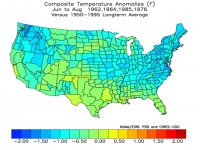
And with summers following high latitude volcanic eruptions:

By the way, the only year common to all the composite sets above is 1976.....hmmmm
CPC’s Climate Model, the CFS agrees. Here is the latest CFS climate models for summer:
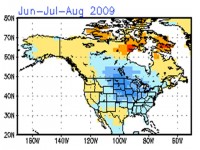
Apr 24, 2009
Sea Ice Claims on Thin Ice
Guest Post by Steven Goddard on Watts Up With That
Last weeks’ top Antarctic AGW story was: Antarctic ice melting faster than expected. due to CO2, of course.
This week the #1 story is: Antarctic ice spreading but the increase in size is due to “stratospheric ozone depletion” which is of course also caused by man-made gases.
So Antarctic ice is disappearing faster than expected due to man, and it is also expanding in size due to man. Meanwhile, the early autumn temperature in Vostok, Antarctica is a toasty -95F, a nice warm up from the -104F temperatures earlier this week.
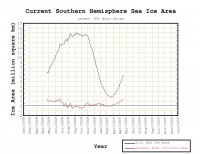
See larger image here
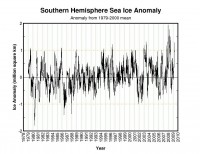
See larger image here
Oh, and one minor problem with the ozone hole theory “The ozone hole occurs during the Antarctic spring, from September to early December” - but the positive ice anomaly occurred during the autumn and winter (March through July) as represented by the red line below. And while the ozone hole was present, ice was normal. So the ice excess probably has nothing to do with the ozone hole.
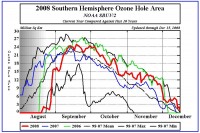
See larger image here
The AGW standard for broad acceptance of new theories seems to be “not completely implausible - if you avoid actually looking at the body of data or what you might have said last week.” Read more and comment here.
|

















